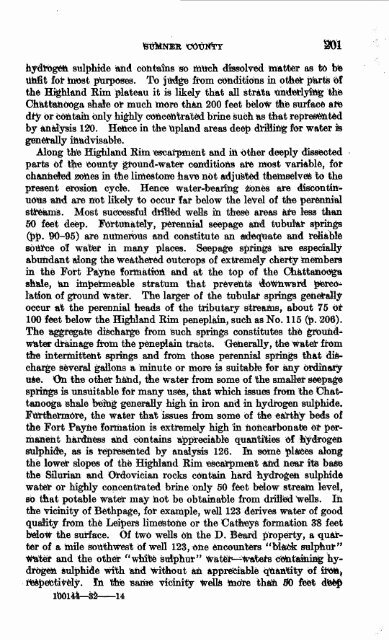GROUND WATER IN NORTH-CENTRAL TENNESSEE
GROUND WATER IN NORTH-CENTRAL TENNESSEE
GROUND WATER IN NORTH-CENTRAL TENNESSEE
Create successful ePaper yourself
Turn your PDF publications into a flip-book with our unique Google optimized e-Paper software.
SOI<br />
hydrogen sulphide and contains so much dissolved matter as to bfe<br />
Unfit for boost purposes. To judge from conditions in other parts of<br />
the Highland Hun plateau it is likely that all strata underlying the<br />
Chattanooga stale or much more than 200 feet beloW tfe'e surface are<br />
dry or c6ntain only highly concentrated brine such as that repress&nted<br />
by analysis 120. Hence in the upland areas deep driilling for water fe<br />
generally inadvisable.<br />
Along the Highland Rim "escarpment and iii other deeply dissected<br />
parts of t!(l« county ground-water conditions are most variable, for<br />
channeled zones in the limestone have not adjusted themselves to the<br />
present erosion cycle. Hence water-bearing £ones are discontin-<br />
u6us atod are not likely to occur far below the level of the perennial<br />
streams. Most successful drilled wells in these areas are less than<br />
50 feet deep. Fortunately, perennial seepage aM tubular springs<br />
(pp. 90-95) are numerous and constitute an idequate and reliable<br />
source ol water in many places. Seepage springs are especially<br />
abundant along the weathered outcrops of extremely cherty members<br />
in the Fort Payne formation and at the top of the Chattanooga<br />
shale, an impermeable stratum that prevents i&OwnwBrd perco<br />
lation of ground Water. The larger of the tubular springs generally<br />
occur at the perennial heads of the tributary streams, about 75 o£<br />
100 'feet below the Highland Rim peneplain, such as No. 115 (p. 206).<br />
The aggregate discharge from such springs constitutes the ground-<br />
water drainage from the peneplain tracts. Generally, the Water from<br />
the mtermittent springs and from those perennial springs that dis<br />
charge several gallons a minute or more is suitable for any ordinary<br />
use. On the other hand, tne water from some of the smaller seepage<br />
springs is unsuitable for many uses, that wnich issues from the Chat<br />
tanooga shale feeing generally high in iron and in hydrogen sulphide.<br />
Furthermore, the water that issues from some of the earthy beds of<br />
the Fort Payne 'formation is extremely high "in hohcarbonate or per<br />
manent hardness and contains appreciable quantities of hydrogen<br />
sulphide, as is represented by analysis 126. Ba some plates along<br />
the lower slopes of the Highland Rim escarpment and near its base<br />
the Silurian and Ordovidan rocks contain hard hydrogen sulphide<br />
water or highly concentrated brine only 50 feet below stream level,<br />
so that potable water may hot be obtainable from drUted wells. Iii<br />
the vicinity of Bethpage, for example, well 123 derives water of good<br />
quality from the Leipers limestone or the Catheys formation 38 feet<br />
below the surface. Of two wells on the D. Beard property, a quar<br />
ter of a mile southwest of well 123, one encounters "black sulphur"<br />
wfeter and the other "whifce sulphur" water^watefs containing hy<br />
drogen sulphide with and without an appreciable quantity of<br />
respectively. Itt the same vicinity wells more tha:n 50 feet

















